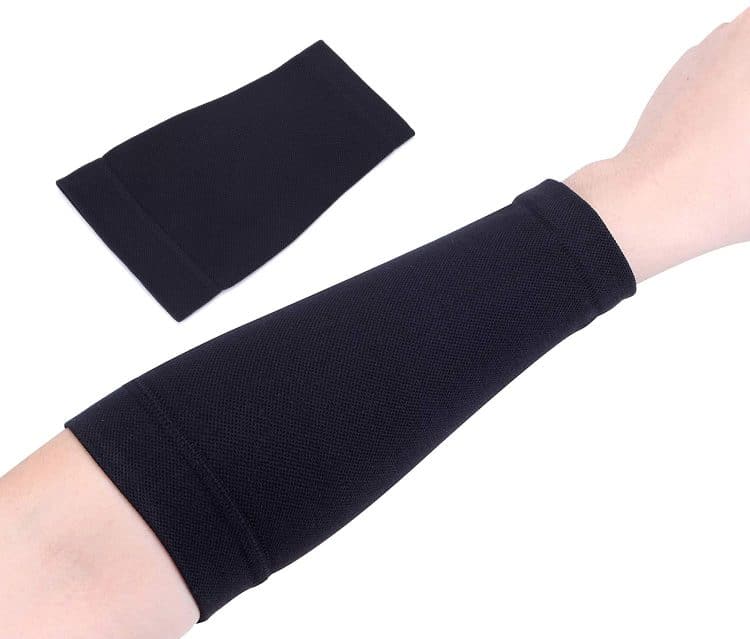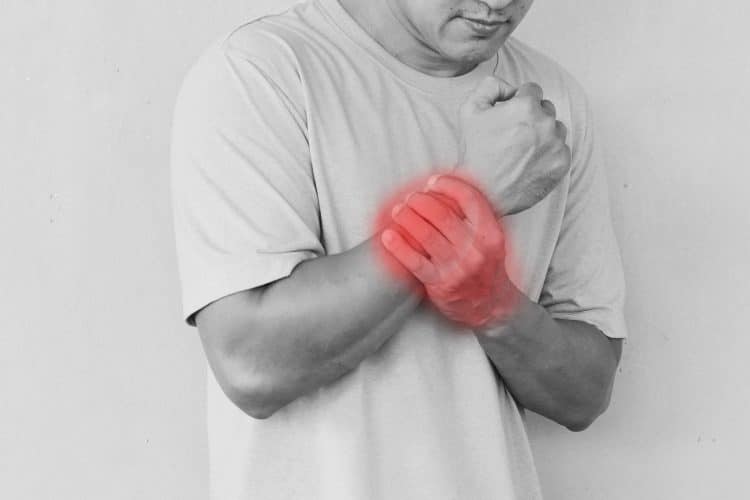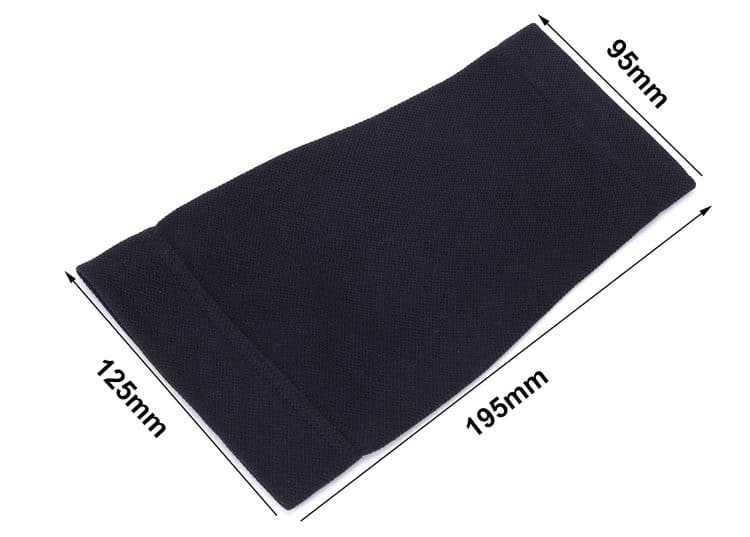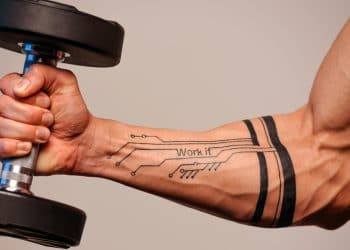If you’re like most athletes, you are probably always looking for ways to improve your training performance. However, there’s only so much adjustment and tweaking you can do to your training style. After a point, using training equipment is the only way to elevate your performance.
Strength sports athletes use forearm compression sleeves, weightlifting belts, lifting straps, and wrist wraps, among other things, to push themselves in training while making their lifts safer.
A forearm compression sleeve is a versatile tool that has various applications. Rock climbers use them to alleviate stress and delay fatigue. Basketball players are probably the most avid users of the forearm compression sleeves and use the gear to delay fatigue and reduce the chances of cramps, DOMS, and injury.
Check Out: The Ultimate Basketball Workout and Diet Plan For Athletes
What is a forearm compression sleeve?
A forearm compression sleeve is a piece of muscle-hugging training gear for your lower arm. Most compression gear uses a mix of spandex, rubber, polyester, and nylon.
Level Up Your Fitness: Join our 💪 strong community in Fitness Volt Newsletter. Get daily inspiration, expert-backed workouts, nutrition tips, the latest in strength sports, and the support you need to reach your goals. Subscribe for free!
The tube-shaped compression gear comes in different shapes and sizes. Some compression sleeves run from shoulder to wrist; others just cover your forearms, beginning at your elbows and ending at your wrists. Many forearm compression sleeves also have patterns that make the gear feel more snug and supportive.
Different people use a forearm compression sleeve for different reasons. While some wear them to save their arms from outdoor heat, others use them for support during exercise. However, compression sleeves do much more than this.
10 Benefits of a Forearm Compression Sleeve
You’ve probably seen pro (and wannabe) athletes wearing tights, which might have left you wondering why they choose to wear restrictive-looking clothing instead of more comfortable outfits.
While compression gear might look limiting, it can, in fact, improve your range of motion and provide support. Here are the benefits of wearing a forearm compression sleeve —
1. Improves Performance
The most understated benefit of a forearm compression sleeve is the impact it can have on your workout performance, which makes it a darling of strength sports athletes.
A forearm compression sleeve keeps your muscles engaged and arms stable when performing strength exercises. Plus, using a compression sleeve is incredibly easy. All it takes is slipping it on before your workout, and you’re good to go.
2. Reduces Muscle Fatigue
Research suggests that wearing compression gear can help reduce muscle soreness and fatigue during and after workouts. Plus, a forearm compression sleeve can result in faster muscle recovery between sets. [1]
3. Keeps Temperature Down While Keeping Your Muscle Warm
No, this isn’t some sorcery.
Although the forearm compression sleeve is tight, it is designed to ensure your movement isn’t restricted. Plus, it allows circulation of air which regulates your muscule temperature and ensures you are not overly warm and uncomfortable during training. [2]
4. Better Muscle Oxygenation
Compression garments are designed to increase the amount of oxygen your muscles receive during exercise. Additionally, compression gear is designed to promote blood flow, which can aid in improving your exercise performance.
Compression can also reduce or prevent swelling and pain during exercise and is particularly useful for old injuries and conditions such as bursitis and stiff muscles.
Check Out: VO2 Max Calculator: Estimate Maximum Volume of Oxygen
5. Minimizes Overexertion
When training for extreme sports, it’s better to have lower perceived exertion as it can reduce the impact on your joints, tendons, and muscles and improve your workout performance.
6. Prevents Pain, Strain, and Discomfort
Compression gear can help reduce your risk of muscle strains. Furthermore, a forearm compression sleeve can aid in strain recovery, making it a great tool for people struggling with an injury.
A study found that some compression garments may help prevent knee injuries, though further research is necessary. A compression sleeve can alleviate discomfort and pain. However, you should talk to a trained medical professional before buying compression gear if you are dealing with an injury. [3]
Related: Natural Joint Pain Remedies
7. Recover Faster
According to The University of Pittsburgh Medical Center (UPMC), R.I.C.E. (rest, ice, compression, and elevation) can help you recover from a strain, sprain, or other similar traumas faster and get back to everyday activities.
A 2014 study found that compression garments promote muscle strength recovery after bouts of resistance training. Furthermore, they can reduce wear and tear on your muscles. [4]
Must Read: 8 Ways to Speed Up Recovery After Training
8. UV Protection
A forearm compression sleeve can act as a great protective layer when exercising outdoors. They can also protect your skin from direct sun exposure.
9. Prevent Muscle Soreness
“I love DOMS,” said no one ever. Delayed onset muscle soreness can be a hurdle in your normal routine, especially if your job requires you to be physically active. Using compression garments can help reduce the frequency and intensity of muscle soreness. [5]
As per a study, compression garments can help reduce muscle soreness and delay the onset of muscle fatigue compared to training without compression gear. [6]
Level Up Your Fitness: Join our 💪 strong community in Fitness Volt Newsletter. Get daily inspiration, expert-backed workouts, nutrition tips, the latest in strength sports, and the support you need to reach your goals. Subscribe for free!
Related: How to Overcome Delayed Onset Muscle Soreness (DOMS)
10. Make You Look Better
Let’s be honest for a minute. People wearing forearm compression sleeves look cool. Furthermore, they are incredibly versatile and can be worn under your clothes.
Risks of a Forearm Compress Sleeve
Although forearm compression sleeves are a great training tool, they come with a few drawbacks. Research suggests that a compression garment that is too tight can cause discomfort and numbness. [5]
Compression clothing is not optimal for individuals with certain health conditions such as malnutrition and broken or damaged skin.
How to Choose the Best Forearm Compression Sleeve?
If you’re on the market for compression gear, you should consider the following six aspects before pulling out your wallet —
1. Material
Many forearm compression sleeves on the market are made with moisture-wicking materials. The quick sweat absorption tech can help improve your workout performance by delaying the onset of fatigue.
You should also consider the fabric’s stretchability as it can determine your range and freedom of motion. Plus, antimicrobial materials may help reduce odor.
2. Thickness
A forearm compression sleeve’s thickness should also be considered before making a purchase. The thickness of the sleeve can dictate its ventilation and comfort.
Furthermore, you should prefer thicker compression gear if you train outdoors as some compression garments contain ultraviolet protection factor (UPF).
3. Size
Shorter arm compression sleeves are geared specifically for elbows, and these are a good option for people suffering from bursitis and other elbow issues.
Your sport will also play a role in determining the size of the forearm compression sleeve that’ll be right for you. If you’re into weightlifting, you might need a compression sleeve that primarily covers your elbow. On the other hand, runners would want a compression sleeve that wraps around their entire arm.
4. Fit
Compression sleeves usually come in a standard size, which might be a little too tight for you if you are a strength sports athlete. You might want to try on a sleeve before buying it because wearing a tight sleeve for too long can cause numbness.
5. Washability
Here’s a secret. No matter how good (read: expensive) your compression gear, it’ll stink after a few intense and sweaty training sessions.
The washability of a forearm compression sleeve will depend on its material quality. Lower-quality sleeves might lose their shape, color, and appearance after a few washes.
6. Price
Once you begin your search for a forearm compression sleeve, you’ll realize that the prices vary greatly. Truth be told, there isn’t much of a difference in the quality and ruggedness of most compression gear on the market.
If you find two products built with the same material but selling for different prices, you should go with the one that is kinder to your wallet.
Related: How To Prevent Forearm Pain When Curling.
Forearm Compression Sleeve Price Range
Now that we have talked about virtually everything there is to about compression sleeves, let’s discuss the price you should be paying for the gear based on your experience level —
- Beginner: Since a newbie won’t probably use the compression sleeve every day, especially if they are into bodybuilding, they shouldn’t spend more than $15 on the training gear.
- Intermediate: Experienced athletes should go for more durable options that range between $15-$30.
- Advanced: Since pros are heavy users, investing in high-quality compression sleeves ($40 and more) will pay dividends in the long run.
Checkout the best rated Compression Sleeve on Amazon.
FAQs
How long do you wear a compression sleeve for forearm pain?
There are two types of body compression gears —
- Medical grade
- Compression garments for weight loss and high-performance sports
Using a forearm compression sleeve while training might help alleviate some forearm strain, but it’s unlikely it will solve the underlying issue. On the other hand, if you are using a medical-grade compression sleeve, you should consult a trained physician and seek their opinion about your condition.
How do I wash a compression sleeve?
Most compression sleeves on the market can be machine washed. Tip — gentle washing of the compression sleeve can make its elasticity last longer.
My forearm compression sleeve slips during training. Is that normal?
If you are facing this issue, you’re probably wearing a compression sleeve one size too big. Your compression gear should always be of a snug fit.
Next Read: 10 Top-Notch Compression Shorts Reviewed for 2024
Wrapping Up
If you’re not using a compression sleeve in your training, you’re leaving gains on the table. However, compression gear is not the be-all and end-all for better muscle recovery, support, and injury prevention.
You need to stretch, hydrate, and use a warm-up and cool-down routine in your workouts along with incorporating certain recovery tools to make the most of your training regimen.
References
- Hong W-H, Lo S-F, Wu H-C, Chiu M-C (2022) Effects of compression garment on muscular efficacy, proprioception, and recovery after exercise-induced muscle fatigue onset for people who exercise regularly. PLoS ONE 17(2): e0264569. https://doi.org/10.1371/journal.pone.0264569
- Engel FA, Holmberg HC, Sperlich B. Is There Evidence that Runners can Benefit from Wearing Compression Clothing? Sports Med. 2016 Dec;46(12):1939-1952. doi: 10.1007/s40279-016-0546-5. PMID: 27106555.
- Zamporri J, Aguinaldo A. The Effects of a Compression Garment on Lower Body Kinematics and Kinetics During a Drop Vertical Jump in Female Collegiate Athletes. Orthop J Sports Med. 2018 Aug 15;6(8):2325967118789955. doi: 10.1177/2325967118789955. PMID: 30140709; PMCID: PMC6096693.
- Goto K, Morishima T. Compression garment promotes muscular strength recovery after resistance exercise. Med Sci Sports Exerc. 2014 Dec;46(12):2265-70. doi: 10.1249/MSS.0000000000000359. PMID: 25003778.
- Xiong Y, Tao X. Compression Garments for Medical Therapy and Sports. Polymers (Basel). 2018;10(6):663. Published 2018 Jun 14. doi:10.3390/polym10060663
- Engel FA, Holmberg HC, Sperlich B. Is There Evidence that Runners can Benefit from Wearing Compression Clothing? Sports Med. 2016 Dec;46(12):1939-1952. doi: 10.1007/s40279-016-0546-5. PMID: 27106555.











